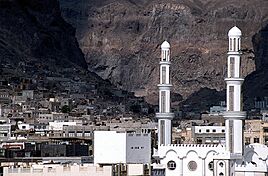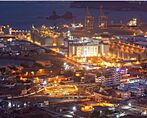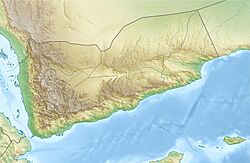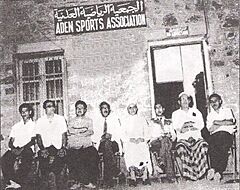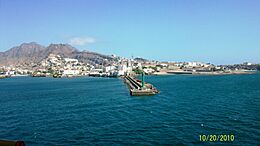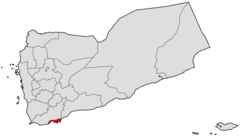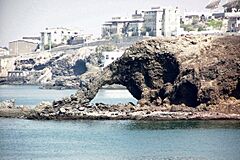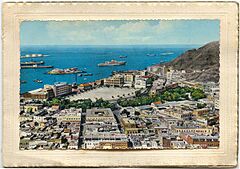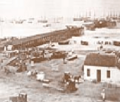Aden facts for kids
Quick facts for kids
Aden
|
|
|---|---|
|
Temporary capital and City
|
|
|
Clockwise from top: Aban Mosque in Crater, Queen Victoria Statue, Port of Aden, Abyan Beach, Crater District, Mualla District
|
|
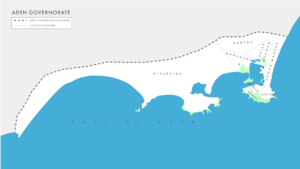
Aden map
|
|
| Country | Yemen |
| Region | Aden Region |
| Governorate | Aden |
| First settled | 7th century BC |
| British occupation | 19 January 1829 |
| Aden Settlement | 1829 |
| Province of Aden | 1932–1937 |
| Colony of Aden | 1 April 1937 |
| State of Aden within the FSA | 18 January 1963 |
| Independence | 30 November 1967 |
| Area | |
| • Total | 760 km2 (290 sq mi) |
| Elevation | 6 m (20 ft) |
| Population
(2017)
|
|
| • Total | 863,000 |
| • Estimate
(2023)
|
1,079,670 |
| • Density | 1,135.52/km2 (2,941.0/sq mi) |
| Demonym(s) | Adeni/Adenies |
| Ethnicities | |
| • Majority | Arabs |
| • Minorities | Afro-Arabs, Indians, Somalis |
| Languages | |
| • Official | Arabic MSA (Education and Government) |
| • Spoken | Adeni Arabic (Majority) English (Widely used) |
| Time zone | UTC+3 (AST) |
| Area code(s) | 02 |
![]() Kingdom of Awsan
Kingdom of Awsan
![]() Himyarite Kingdom
Himyarite Kingdom
![]() Kingdom of Aksum
Kingdom of Aksum
![]() Sasanian Yemen
Sasanian Yemen
![]() First Islamic state
First Islamic state
![]() Rashidun Caliphate
Rashidun Caliphate
![]() Umayyad Caliphate
Umayyad Caliphate
![]() Abbasid Caliphate
Abbasid Caliphate
![]() Ziyadid dynasty
Ziyadid dynasty
![]() Najahid dynasty
Najahid dynasty
![]() Sulayhid dynasty
Sulayhid dynasty
![]() Zurayid dynasty
Zurayid dynasty
![]() Ayyubid dynasty
Ayyubid dynasty
![]() Rasulid dynasty
Rasulid dynasty
![]() Tahirid Sultanate
Tahirid Sultanate
![]() Mamluk Sultanate
Mamluk Sultanate
![]() Portuguese Aden
Portuguese Aden
![]() Yemen Eyalet
Yemen Eyalet
![]() Qasimid State
Qasimid State
![]() Yemen Vilayet
Yemen Vilayet
![]() Qasimid State
Qasimid State
![]() Sultanate of Lahej 1728–1839
Sultanate of Lahej 1728–1839
![]() Aden Province 1839–1937
Aden Province 1839–1937
![]() Aden Colony 1937–1963
Aden Colony 1937–1963
![]() Aden protectorate 1937–1963
Aden protectorate 1937–1963
![]()
![]() State of Aden within the FSA 1963–1967
State of Aden within the FSA 1963–1967
![]() South Yemen 1967–1990
South Yemen 1967–1990
![]() Republic of Yemen 1990–1994
Republic of Yemen 1990–1994
![]() Democratic Republic of Yemen 1994
Democratic Republic of Yemen 1994
![]() Republic of Yemen 1994–present
Republic of Yemen 1994–present

Aden (Arabic: عَدَنْ, romanized: ʿAdan, Old South Arabian: 𐩲𐩵𐩬) is a port city located in Yemen in the southern part of the Arabian peninsula, positioned near the eastern approach to the Red Sea. It is situated approximately 170 km (110 mi) east of the Bab-el-Mandeb strait and north of the Gulf of Aden. With its strategic location on the coastline, Aden serves as a gateway between the Red Sea and the Arabian Sea, making it a crucial maritime hub connecting Africa, Asia, and the Middle East. As of 2023, Aden City has a population of approximately 1,080,000 residents, making it one of the largest cities in Yemen. Aden is divided into eight districts: Tawahi, Mualla, Crater, Khur Maksar, Al Mansura, Dar Sad, Sheikh Othman, and Al Buraiqa. These form today's Aden Governorate. During British Colonialism, Aden referred to the area along the north coast of the Gulf of Aden, encompassing Tawahi, Mualla, Crater, and much of Khur Maksar District. The western harbor peninsula, known as Little Aden, now falls within the Al Buraiqa District.
Before gaining independence, Aden comprised distinct sub-centers: Crater, the original port; Ma'alla, the modern port; Tawahi, formerly "Steamer Point"; and Gold Mohur resorts. Khormaksar, on the isthmus connecting Aden to the mainland, hosts diplomatic missions, Aden University's main offices, and Aden International Airport. On the mainland, sub-centers include Sheikh Othman, an old oasis area; Al-Mansura, a British-planned town; and Madinat ash-Sha'b (formerly Madinat al-Ittihad), the former capital of the South Arabian Federation, now housing a large power/desalination facility and additional Aden University faculties.
Aden encloses the eastern side of a vast, natural harbour that constitutes the modern port. A long time ago this necessitated the existence of Aden's reservoirs, the Cisterns of Tawila. As described by 14th century scholar Ibn Battuta, "These reservoirs accumulate rainwater for the sole purpose of drinking for the city's citizens." Little Aden became the site of the oil refinery and tanker port. Both were established and operated by British Petroleum until they were turned over to South Yemeni government ownership and control in 1978.
Aden used to be the capital of South Yemen until its unity with North Yemen in 22 May 1990. It is currently the temporary capital of Yemen since the 2014 Coup d'état, hosting some members of the Cabinet of Yemen mainly in al-Maashiq Palace. It is also the seat of the secessionist Southern Transitional Council, which exercises control over the city.
Contents
Etymology
Aden is a home and a place for ships, and the word Aden means reside in the place, so the word “Aden” means resident, and it is said “Aden Al-Balad,” meaning the settlement of the country. Among the sayings of geographers about the city:
Yaqut al-Hamwi said: "It is a famous city on the coast of the Indian Sea, towards the Yemen, and it is poor, with no water or pasture. They drink from a spring between it and Aden, about a distance of about today, and despite that, it is bad, except that this place is the port for Indian ships, and merchants gather there for that reason, as it is a town of trade." And it is added to Abyan, which is the opposite of Aden in its entirety.
Ibn Manzur said: “It is a country on the edge of the sea in the farthest part of Yemen.”
Ibn Khaldun said: “This Aden is one of the most fortified cities in Yemen, and it is on the bank of the Indian Sea. It is still a country of trade from the time of the Trabaids, and most of them were built with stones, which is why silk merchants visit it often.”
Antiquity
Aden is an ancient port and was mentioned by the Greeks under the name (Ancient Greek: Αραβία Εμπόριον, romanized: Arabia Emporion), which means an Arabic trade port. The port's convenient position on the sea route between India and Europe has made Aden desirable to rulers who sought to possess it at various times throughout history. Known as Eudaemon (Ancient Greek: Ευδαίμων, meaning "blissful, prosperous,") in the 1st century BC, it was a transshipping point for the Red Sea trade, but fell on hard times when new shipping practices by-passed it and made the daring direct crossing to India in the 1st century AD, according to the Periplus of the Erythraean Sea. The same work describes Aden as "a village by the shore," which would well describe the town of Crater while it was still little-developed. There is no mention of fortification at this stage, Aden was more an island than a peninsula as the isthmus (a tombolo) was not then so developed as it is today. Aden was explicitly mentioned by this name in the Book of Ezekiel, which talks about Jerusalem, and it says:
"The merchants of Sheba and Raamah are your merchants. They set up your markets with the finest perfumes and every precious stone and gold. Harran, Qena, and Aden are the merchants of Sheba, and Assyria and Kilmud are your merchants."
At its beginning, the city was a small peninsula with no significant natural resources, but its location between Egypt and India made it important in the ancient global trade route. The city was the home of the ancient Kingdom of Osan from the eighth to seventh centuries BC. In the beginning of the seventh century BC, Karbil Watar I, king of the Kingdom of Sheba, launched a campaign against Osan during which, according to the Sabaean texts, sixteen thousand people were killed, forty thousand people were enslaved, and the kings of Awsan made offerings to the god. al-Maqah, according to the inscription that Karbiel Watar I left in Sirwah, commemorating his victory.
In the second half of the first century BC, the Roman Emperor Augustus Caesar determined to control Arabia Felix and reach the Indian Ocean. The Roman governor of Egypt, Aelius Gallus, was sent in 25 BC. The campaign ended with disastrous results and the annihilation of the Roman army in front of the walls of Ma'rib. The Himyarites overthrew the Kingdom of Sheba in 275 AD and took control of Aden. Recent incomplete archaeological studies suggest that the Himyarites were the ones who built the huge water cisterns currently known as the “Cisterns of Aden,” which stored approximately 136,382,757 liters of water.
The Himyarite Kingdom fell in the first quarter of the sixth century AD. Yusuf Dhu Nuwas mentioned Bab al-Mandab in one of his writings. The forces of the Kingdom of Aksum were entering Yemen through it. The Byzantine Emperor Justinian I sent a fleet to fight the Himyarite Jews and support the Kingdom of Aksum and the Christians of Najran. The fleet entered through Aden. Byzantine sources indicate that the Sasanian Empire took control of the city in 671 AD.
A local legend in Yemen states that Aden may be as old as human history itself. Some also believe that Cain and Abel are buried somewhere in the city.
Culture
Dialects
The entry of the Yemenis into Islam contributed to their abandoning their ancient pen and replacing it with the late Nabataean alphabet in which the Qur’an was written. Today, Yemenis speak Arabic in the Yemeni dialect, which is a developed dialect and closely linked to the ancient language. It has three dialects with branches: the Sana’i dialect, the Hadrami dialect, and the Ta’izi-Adeni dialect, in addition to the Bedouin dialect of the residents of Ma’rib. Al-Jawf, Shabwa, and Badia Hadhramaut, and each of these dialects has characteristics and features.
Music and poetry
Adeni art or the Adeniyat is an art of Arabic music. Among the ancient artists of Aden are Iskander Thabet Saleh and Muhammad Murshid Naji, and among the poets are Abdul Rahman Ibrahim Muhammad, Ahmed Ghaleb Muhammad Al-Jabri, Abdullah Abdul Karim Muhammad, Ali Abdullah Jaafar Aman, Farid Muhammad Barakat, Lotfi Jaafar Aman, and Mohsen Ali Brik.
“Adeni music” played a major role in Aden society, and artists in the Aden dialect were called “al-Mutariba,” meaning people of music. Adeni music began in 1920 when the army of the Aden Protectorate was formed, and after it the National Guard, where there were teams for those forces and those teams participated On special occasions and weddings.
Sports
Pre-independence
The first beginning of Adenian sports dates back to the year 1902 AD, when the Adeni Tennis Club was established, with its headquarters in the Al-Qatee’ neighborhood in Crater, and Youssef Muhammad Khan founded the “Recreational Club United” in the city of Crater, and it was known as the Yousef Khan Stadium. The city of Aden is considered the first city in which sports were practiced in the Arabian Peninsula, and the first private club in Aden was founded in 1905 under the name “Al-Ittihad Al-Muhammadi Club,” as the first sports club in Yemen and the Arab world. He was fighting the occupation army divisions and the fleet divisions coming and passing to the port of Aden.
In 1924, the “Al-Husseini Sports Club” was founded in Crater, and a third club appeared in Tawahi under the name “Al-Bamboot Club” and Sheikh Othman. The 1930s witnessed the emergence of a number of clubs. In 1933 AD, the “Nujoom Al-Layl Club”, Al-Aidrousi Club, and Nujoom Al-Sabah Club appeared in Crater, and in Tawahi, the “Al-Ittihad Al-Islami Club” (Al-Mawlada) appeared.
Until that year, football matches were played in a friendly manner between the teams of the Crater, Al-Tawahi, and Sheikh Othman regions, as there were no federations regulating sports activity. In 1934 AD, the occupation authority announced the establishment of a sports association called the “Adeniya Sports Association,” after the increasing number of local clubs. Its members were appointed by the Governor-General of Aden, and all of its members were English, headed by the English Governor of Aden, “Bernard Reilly,” as sponsor. The association's board of directors consists of Hikam Bottom as president, the Indian Rosario as secretary, and two other members.
This association began holding the first club tournament, which was the “Rosario Cup Championship.” Six clubs participated in the tournament, three from Crater (Al-Ittihad Al-Mohammadi, Al-Husseini, and Nojoom Al-Layl), from Al-Tawahi (Al-Mawalda, and Al-Bamiot), and from Sheikh Othman, Sheikh Othman Club, which includes Players from various small teams in the Sheikh Othman area, and Al-Ittihad Al-Mohammadi Club won this championship.
Among the most important tournaments held in Aden before independence were the Rosario Cup, the Riley Cup, the Somali Bassem Al-Nar Cup, the Aramco Cup, and the Kik Muncherji Championship.
Post-independence
After independence, the “Football Federation” was established on January 18, 1968, on the ruins of the “Adeniya Sports Association.” The Federation took a decision regarding the Adeniya clubs, which had numbered about 64 sports clubs, reducing and merging the clubs in Aden and Lahj to only 16 clubs, and the clubs were forced to join or unite with large teams. In February 1968, several sports clubs were abolished, leaving only 12 clubs remaining. In December 1968, Al-Islah Club and Al-Shaab Club were merged into one club under the name of the latter in Al-Tawahi. In 1969, the Al-Ittihad Al-Muhammadi Club and Al-Tadamon Club were united in Crater, under the name Al-Tadamon Al-Muhammadi Club.
In the “First General Sports Conference” in 1973, the clubs were merged and reduced again, so that their number became only 7 clubs: Al-Ahrar Club, Al-Ahly Club, Shamsan Club, Al-Shaab Club, Al-Hilal Club, United Youth Club, and Aden Tennis Club. On July 18, 1975, the stage of forming urban clubs, and the beginning of the stage of politicization of the clubs in favor of the National Liberation Front, took place. It was decided to change their names and reduce them to become 5 clubs: Al-Tilal Club, Shamsan Club, Al-Minaa Club, Al-Wahda Club, and Al-Shoula Club.
On July 18, 1975, the “Al-Tilal Sports Club” appeared, headed by Yassin Saeed Noman, as a new name for the “Al-Ittihad Al-Muhammadi Club,” which was founded in 1905, and in 1976 the “Yemeni Football Federation” appeared. Al-Tilal Club participated in the “September 26 Cup Competition” in 1980, as the first football competition in which it participated with teams from northern and southern Yemen, such as the national team of Ibb Governorate, Taiz Governorate, Hadhramaut Governorate, Lahj and Hodeidah, at the Shaheed Al-Dharafi Stadium in Sana’a, and Al-Hilal was crowned champion of the September 26 Cup, after victory over Hodeidah national team by five clean goals.
Football is the most popular sport in Aden. There are 9 stadiums in Aden, including the May 22 International Stadium, and 10 sports clubs. In November 2010, Aden hosted the 2010 Arabian Gulf Football Cup.
Tourist sites
Aden has a number of historical and natural sites of interest to visitors. These include:
- The historical British churches, one of which lies empty and semi-derelict in 2019.
- The Zoroastrian Temple
- The Cisterns of Tawila—an ancient water-catchment system located in the sub-centre of Crater
- Sira Fortress
- The Aden Minaret
- Little Ben, a miniature Big Ben Clock Tower overlooking Steamer Point. Built during the colonial period, this was restored in 2012 after 3 decades of neglect since the British withdrawal of 1967.
- The Landing Pier at Steamer Point is a 19th-century building used by visiting dignitaries during the colonial period, most notably Queen Elizabeth during her 1954 visit to the colony. This building was hit by an airstrike in 2015 and is currently in the process of being restored in 2019.
- The Crescent Hotel which contained a number of artifacts relating to the Royal Visit of 1954 and which currently remains derelict as a result of a recent airstrike.
- The Palace of the Sultanate of Lahej/National Museum—The National Museum was founded in 1966 and is located in what used to be the Palace of the Sultanate of Lahej. Northern forces robbed it during the 1994 Civil War, but its collection of pieces remains one of the biggest in Yemen.
- The Aden Military Museum which features a painting depicting the 20 June 1967 ambush by Arab Police Barracks on a British Army unit when a number of the 22 soldiers killed that day were driving in two Land Rovers on Queen Arwa Road, Crater.
- The Rimbaud House, which opened in 1991, is the two-story house of French poet Arthur Rimbaud who lived in Aden from 1880 to 1891. Rimbaud moved to Aden on his way to Ethiopia in an attempt for a new life. As of the late 1990s, the first floor of the house belonged to the French Consulate, a cultural centre and a library. The house is located in al-Tawahi—the European Quarter of Aden—and is politically and culturally debated for its French nature in an area previously colonized by Britain.
- The fortifications of Jebal Hadid and Jebal Shamsan
- The beaches of Aden and Little Aden—Some of the popular beaches in Aden consist of Lover's Bay Beach, Elephant Beach and Gold Beach. The popular beach in Little Aden is called Blue Beach. Some beaches are private and some are public, which is subject to change over time due to the changing resort industry. According to the Wall Street Journal, kidnappings on the beaches and the threat of Al Qaeda has caused problems for the resort industry in Aden, which used to be popular among locals and Westerners.
- Al-Aidaroos Mosque
- Main Pass – now called Al-Aqba Road is the only road into Aden through Crater. Originally an Arched Upper bridge known as Main Gate, it overlooked Aden city and was built during the Ottoman Empire. A painted crest of the 24th British army battalion is still visible on the brickwork adjacent to the Gate site and is believed to be the only remaining army Crest from colonial rule still visible in Aden. In March 1963 the bridge was removed by a British Army controlled explosion to widen the 2 lane roadway to the present 4 lane highway and the only reminder of this bridge is a quarter scale replica built at the end of the Al-Aqba road intersection known as the AdenGate Model roundabout.
Economy and transportation
The industrial activity in Aden is represented by a group of factories and production units, the forefront of which is the oil refinery. The oil refinery in Aden is considered one of the first refineries to be established in the region, and began operating in 1954 AD. The Aden Refineries Company has facilities such as an oil tanker port, a network of storage tanks, and a center to supply ships with fuel.
Historically, Aden was a station for importing goods from the African coast and from Europe, the United States, and India. As of 1920, Aden was a major commercial center for trade in the Arabian Peninsula, and the port exported small quantities of local products to most Arab ports. Aden provided coal and salt to passing ships, and the port was a stopping point for ships when they entered Bab al-Mandab.
Transport
Historically, the port of Aden was the main transport port in the region. Passenger ships land in Al-Tawahi District, and the city is served by Aden International Airport, which is about 10 kilometers (6 mi) from the city. The airport is the main headquarters of Al-Saeeda Airlines and its operations center. The airport is considered the second largest airport. In Yemen, after Sana'a International Airport, it is considered the best airport in Yemen in terms of location due to the mountainous nature of Yemen. However, this airport is surrounded by the Arabian Sea in terms of take-off and landing. The establishment of Aden Airport dates back to the year 1927 when the British forces established a military airport in the district. Khor Maksar. After World War II, Britain carried out extensive urban modernization and built Aden International Airport, known today, next to the military airport. Al-Yamda Airlines was the official carrier of South Yemen, before unification, and was based in Aden, before merging with Yemen Airways in 1996. Before the Battle of Aden Airport and the 2015 military intervention in Yemen closed this airport along with other airports in Yemen. On 22 July, Aden International Airport was declared fit for operation again after the Houthi forces were driven from the city, and a Saudi plane carrying aid reportedly became the first plane to land in Aden in four months. The same day, a ship chartered by the World Food Programme carrying fuel docked in Aden's port.
Historically, Aden's harbour has been a major hub of transportation for the region. As of 1920, the harbour was 13 by 6 km (8 by 4 mi) in size. Passenger ships landed at Steamer Point now called Tawahi.
During the British colonial period motor vehicles drove on the left, as in the United Kingdom. On 2 January 1977, Aden, along with the rest of South Yemen, changed to driving on the right, bringing it into line with neighbouring Arab states.
During the early 20th century, Aden was a prominent export center for coffee grown in the Jubail highlands. And also to export frankincense, wheat, barley, alfalfa and millet, which are produced and exported from Aden. The leaves and stems of clover, millet, and corn produced in Aden were generally used as fodder. Beginning in 1920, Aden was desalinating seawater to produce table salt. Between 1916 and 1917, Aden produced more than 120,000 tons of salt. Aden also produced potash, which was exported to Mumbai.
Economy
Historically, Aden would import goods from the African coast and from Europe, the United States, and India. As of 1920, the British described it as "the chief emporium of Arabian trade, receiving the small quantities of native produce, and supplying the modest wants of the interior and of most of the smaller Arabian ports." At the docks, the city provided coal to passing ships. The only item being produced by the city, as of 1920, was salt. Also, the port was the stop ships had to take when entering the Bab-el-Mandeb; this was how cities like Mecca had received goods by ship. Yemen Airlines, the national airline of South Yemen, had its head office in Aden. On 15 May 1996, Yemen Airlines merged with Yemenia.
During the early 20th century Aden was a notable centre of coffee production. Women processed coffee beans, grown in the Yemen highlands. Frankincense, wheat, barley, alfalfa, and millet was also produced and exported from Aden. The leaves and stalks of the alfalfa, millet and maize produced in Aden were generally used as fodder. As of 1920, Aden was also gathering salt from salt water. An Italian company called Agostino Burgarella Ajola and Company gathered and process the salt under the name Aden Salt Works. There was also a smaller company from India, called Abdullabhoy and Joomabhoy Lalji & Company that owned a salt production firm in Aden. Both companies exported the salt. Between 1916 and 1917, Aden produced over 120,000 tons of salt. Aden has also produced potash, which was generally exported to Mumbai.
Aden produced jollyboats. Charcoal was produced as well, from acacia, and mainly in the interior of the region. Cigarettes were produced by Jewish and Greek populations in Aden. The tobacco used was imported from Egypt.
Since the outbreak of the Yemeni Civil War spread to Aden in 2015, the city has been struck by constant protests over a range of issues, but especially concerning electricity generation. Aden's power grid is composed solely of diesel generators and is thus heavily dependent on imported fuel. The main power plant is al-Hasswa diesel power plant, which in June 2021 had only two turbines out of five running, producing up to 50 megawatts (MW) of power in a region where the deficit hovers around 300 MW. Nawfal al-Mojamal, the plant director, said "In its 35 years of existence, al-Hasswa station never had any kind of maintenance, except in 2016 ... when the two turbines were restored".
Free zone
The free zone, which was opened in 1991, represents Yemen's economic gateway and the meeting point of the continents of Asia and Africa. The free zone gains its strategic importance from the special location of the port of Aden, as it is located directly on the main trade route around the world and from the Middle East to Europe and America, and is distinguished by the possibility of providing transit services. To East Africa, the Red Sea, the Indian subcontinent and the Arabian Gulf. The free zone represents a storage and distribution area suitable for Africa, the Red Sea and the Arabian Gulf.
Geography and climate
Geography
Aden is located on the coast of the Gulf of Aden, and is about 363 kilometers away from the capital, Sana’a. It is located between latitudes 47 and 12 north of the equator, and at an altitude of 6 meters above sea level. It is surrounded by Lahj Governorate to the north and east, and the Governorate of Abyan is from the northwest, and Aden has an air port represented by Aden International Airport, and a sea port represented by the port of Aden, and it has land routes from the north linking it to Hajj, Abyan and Taiz.
Landforms
The city of Aden is a coastal city, as it overlooks a large body of water, the Gulf of Aden, which in turn opens to the Indian Ocean. The shape of the city of Aden in the form of two peninsulas helped this factor to make the city of Aden unique in this particularity, which clearly affected the occurrence of the phenomenon of land and sea breezes. Which occurs due to air exchange between land and water during the day and night. Its location on the water surface also affects the daily and annual temperature range. This does not mean that there are no significant differences in temperatures in summer and winter.
The surface of the city of Aden slopes south, and the highlands appear in the southern part of Aden, represented by the highlands of Jabal Shamsan, whose highest peaks exceed 500 metres, and the highlands of Jabal Ihsan and Jabal Al-Muzalqim in Little Aden, which are lower in height than Jabal Shamsan, and the highlands of Aden do not differ from the rest of the highlands of Yemen in terms of In terms of composition, it is of volcanic origin, and although the mountain highlands occupy large areas of the city, their influence is weak and limited on the climate of the city of Aden.
Climate
Aden has a hot desert climate (BWh) in the Köppen-Geiger climate classification system. Although Aden sees next to no precipitation year-round, it is humid throughout the year.
| Climate data for Aden | |||||||||||||
|---|---|---|---|---|---|---|---|---|---|---|---|---|---|
| Month | Jan | Feb | Mar | Apr | May | Jun | Jul | Aug | Sep | Oct | Nov | Dec | Year |
| Record high °C (°F) | 31.1 (88.0) |
31.7 (89.1) |
35.0 (95.0) |
37.8 (100.0) |
41.1 (106.0) |
41.1 (106.0) |
41.1 (106.0) |
42.8 (109.0) |
38.3 (100.9) |
38.9 (102.0) |
35.0 (95.0) |
32.8 (91.0) |
42.8 (109.0) |
| Mean daily maximum °C (°F) | 28.5 (83.3) |
28.6 (83.5) |
30.2 (86.4) |
32.2 (90.0) |
34.1 (93.4) |
36.6 (97.9) |
35.9 (96.6) |
35.3 (95.5) |
35.4 (95.7) |
33.0 (91.4) |
30.7 (87.3) |
28.9 (84.0) |
32.4 (90.3) |
| Daily mean °C (°F) | 25.7 (78.3) |
26.0 (78.8) |
27.2 (81.0) |
28.9 (84.0) |
31.0 (87.8) |
32.7 (90.9) |
32.1 (89.8) |
31.5 (88.7) |
31.6 (88.9) |
28.9 (84.0) |
27.1 (80.8) |
26.0 (78.8) |
29.1 (84.4) |
| Mean daily minimum °C (°F) | 22.6 (72.7) |
23.2 (73.8) |
24.0 (75.2) |
25.6 (78.1) |
27.7 (81.9) |
28.8 (83.8) |
28.0 (82.4) |
27.5 (81.5) |
27.8 (82.0) |
24.6 (76.3) |
23.2 (73.8) |
22.9 (73.2) |
25.5 (77.9) |
| Record low °C (°F) | 15.6 (60.1) |
17.2 (63.0) |
18.9 (66.0) |
18.9 (66.0) |
21.1 (70.0) |
23.9 (75.0) |
22.8 (73.0) |
23.3 (73.9) |
25.0 (77.0) |
18.9 (66.0) |
18.3 (64.9) |
16.7 (62.1) |
15.6 (60.1) |
| Average precipitation mm (inches) | 6 (0.2) |
3 (0.1) |
5 (0.2) |
2 (0.1) |
1 (0.0) |
0 (0) |
3 (0.1) |
3 (0.1) |
5 (0.2) |
1 (0.0) |
3 (0.1) |
5 (0.2) |
36 (1.4) |
| Average precipitation days (≥ 0.1 mm) | 3 | 2 | 2 | 2 | 1 | 1 | 2 | 2 | 1 | 1 | 1 | 3 | 20 |
| Average relative humidity (%) | 72 | 72 | 74 | 74 | 72 | 66 | 65 | 65 | 69 | 68 | 70 | 70 | 70 |
| Mean monthly sunshine hours | 241.8 | 203.4 | 217.0 | 240.0 | 303.8 | 282.0 | 241.8 | 269.7 | 270.0 | 294.5 | 285.0 | 257.3 | 3,106.3 |
| Mean daily sunshine hours | 7.8 | 7.2 | 7.0 | 8.0 | 9.8 | 9.4 | 7.8 | 8.7 | 9.0 | 9.5 | 9.5 | 8.3 | 8.5 |
| Source: Deutscher Wetterdienst | |||||||||||||
| Jan | Feb | Mar | Apr | May | Jun | Jul | Aug | Sep | Oct | Nov | Dec |
|---|---|---|---|---|---|---|---|---|---|---|---|
| 25 °C (77 °F) | 25 °C (77 °F) | 26 °C (79 °F) | 27 °C (81 °F) | 29 °C (84 °F) | 30 °C (86 °F) | 29 °C (84 °F) | 29 °C (84 °F) | 30 °C (86 °F) | 28 °C (82 °F) | 27 °C (81 °F) | 25 °C (77 °F) |
Environment
Coasts
Most of the coasts of Aden Governorate along the coastal strip are sandy coasts, and the governorate has coastal beaches, including the Golden Coast in Al-Tawahi District, the coast of Abyan Bakhour Maksar, Al-Ghadeer Beach, and Kud Al-Nimr Beach in Buraiqa.
Offshore islands
There are about 21 islands around the peninsulas of Aden, Aden Lesser, and Ras Amran. They are mostly rocky islands, some of which are surrounded by incomplete coral reefs, and most of them are considered fishing areas. A number of islands have many activities, especially on Al-Ummal Island and Sirah Island.
Wild and domestic animal diversity
Yemen is considered one of the countries rich in bird species in the Middle East due to the availability of many suitable coastal environments that helped attract many migratory birds to wetland sites, coasts and islands. The Aden region (Khor Maksar - Al-Haswah) was registered on the list of important areas of the World Bird Organization as a habitat. The last three species that are globally threatened with extinction are: the great eagle, the gull eagle, and the eastern king eagle.
There are dozens of bird species recorded in the wetlands of Aden and the Caltex swamp area, which are rich in a wide variety of endemic and migratory birds, including birds that are present throughout the year. There are many birds in the area, including great flamingos, dwarf flamingos, and rock egrets. And the spoonbill, the hooked tern and the seagull.
Public services
Education
There are 95 schools in Aden, including 13 kindergartens, and 82 basic education schools, including 29 schools for boys, 29 schools for girls, and 29 joint schools for boys and girls. There are also 29 secondary schools, including 15 schools for boys and 14 schools for girls, all of which are in a double shift system. Until 2004, the number of male students reached In basic education, there were 57,941 students and 48,081 female students, with a total of 104,622 students. In secondary education, the number of male students reached 11,029 students, and 9,643 female students.
As for vocational, technical and vocational education centers and institutes, their number is 13, with 2,214 students enrolled, including 453 teachers. The health institutes have one institute, with 864 students enrolled, including 147 teachers, according to 2010 statistics. As for higher education, there is one government university in Aden, which is the University of Aden, which has 9 colleges. More than 29 thousand students are enrolled, according to 2010 statistics.
Aden has known mail since June 15, 1839, that is, a year after the British occupation, although the official post office was not inaugurated until 1857. Postage stamps of both Britain and India were used in Aden until it became called the Aden Colony on April 1, 1937, although the stamps of this stage It bears no distinctive sign, but the use of the number 124 as a postal code is attributed to Aden as part of the Indian postal numerical system.
Then, when it became a colony in 1937, it had sets of postage stamps containing pictures and the name Aden printed on them. In 1939, a new postage set was issued containing a picture of King George VI, but the Sultans of Hadhramaut - who were under the umbrella of the Aden Protectorate - controlled Britain has had it since the 1880s - they refused to do so, and so Britain issued a separate postal set in 1942, but this time with the inclusion of a phrase and pictures expressing the Kathiri Sultanate in Sayun and the Qu’aiti Sultanate in Shihr and Mukalla, in addition to pictures of the sultans.
Media
Journalism
The weekly Al-Amal newspaper was founded in 1957 in Aden. Its slogan was (Freedom, Bread, and Peace). The British authorities allowed only 1,500 copies to be printed weekly, and the newspaper was banned shortly after.
In 1958, Al-Ayyam newspaper was established in Aden, as an independent daily newspaper in the Arabic language, during the British occupation. The first issue was published on July 30, 1958, and its founder and editor-in-chief was Brigadier General Muhammad Ali Bashraheel. It stopped publishing after independence during the era of the People’s Democratic Republic of Yemen, and then resumed publication. After achieving Yemeni unity, the first issue of the second edition was on November 7, 1990 after a hiatus that lasted more than 23 years. In 1998, Al-Ayyam was the first newspaper in Yemen that the government prosecuted under a criminal law. Other cases followed until it became public by the end of the year. 2008, responsible for 73% of the total number of cases filed by the Ministry of Information and the Yemeni government against the press in Yemen. When the protests and clashes intensified in Aden in April 2009, “Al-Ayyam covered the events extensively, and pictures of blood and injuries were on the cover of the newspaper for days.” President Ali Abdullah Saleh sent delegations to the newspaper, asking them to reduce the severity of their coverage, and to stop using pictures of the injured and bleeding blood. On May 12, 2009, security forces launched an attack on the headquarters of Al-Ayyam newspaper in Aden.
Radio and television
Radio Aden was established on August 17, 1954 under the name “Aden Radio Station.” It is currently broadcast in two periods, morning and evening. The British occupation opened the Aden Channel on September 11, 1964, following the revolution of October 14, 1963. Television transmission was limited to covering populated neighborhoods in the city of Aden, especially where soldiers and families of the British forces were present. In January 1979, the television headquarters moved to the “Radio and Television Building” in Tawahi. Which was prepared, and at that time the broadcast was in black and white, and in March 1981 the gradual transition to color broadcasting began, and in June 1981 the channel began broadcasting via satellite. After the Yemeni unification on May 22, 1990, Aden Channel was the second official channel of Yemeni TV.
Notable people
- Shafiqa Zawqari (born 1942) - author
Images for kids
-
1955 British passport for former Aden protectorate citizens – Qu'aiti State in Hadhramaut
See also
 In Spanish: Adén para niños
In Spanish: Adén para niños


